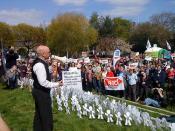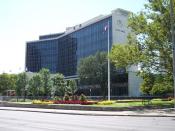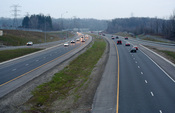The Red Hill Creek Expressway has been an ongoing issue for nearly five decades. (Peace, 2001) Since the beginning of the 1950's, the Red Hill Valley has remained an area without the disturbance of urban development. It has become an area agriculturally cultivated and undeveloped. (Peace, 2001)Unfortunately, with the rapid population growth after WWII, the City of Hamilton became extremely vulnerable to industrial development. (Peace, 2001)Hamilton's population increased by 100 000 people from the early 1940's to the beginning of the 1960's. (Peace, 2001)In 1951, the construction of an expressway through the Red Hill Valley was proposed. (Peace, 2001) Since its first proposal in 1951 and its rejection in 1987, the controversy about the construction of the expressway has raged on. (Peace, 2001) The introduction of the expressway into the Red Hill Valley has significant impacts on Hamilton's land use, future development and downtown core.
The construction of the Red Hill Valley Expressway produces many positive and negative impacts on the Hamilton region.
The construction of the Expressway will provide a significant and effective use of land for transportation. It will provide better accessibility for residence living in the surrounding region, which will in turn decrease traveling time. It was predicted that by the year 2001, automobiles on Highway 20 and Mount Albion Road would rise to 3 900 per hour. (Plinte, 1997) However, a proposition was introduced which involved the extension of Highway 20 instead of constructing the Red Hill Expressway. This proposition was unfortunately too expensive, and would result in future congestion and ridiculous costs of over 200 million dollars. (Minor, 1997) Therefore, due to the overwhelming traffic on Highway 20 and Mount Albion, (approximately 2 600 during rush hour) the Expressway will serve to increase the efficiency of Hamilton's land and transportation routes. (Dolbec, 1998) This idea can be related to Alfred Weber's Industrial Location Theory. Weber's theory states when distance from the central market is increased, transportation costs increase as well. The construction of the expressway allows easy transportation access for all industries in the Hamilton area. Therefore, this effective transportation route will save time and money, not only for industries in the Hamilton region but for other companies as well. Unfortunately, the introduction of the Red Hill Expressway will have a serious environmental impact on the surrounding Red Hill Creek area. External affects on the natural habitat of mammals, birds, fish and plant species will be directly affected. Thousands of plant, animal and fish populations have made homes in the surrounding environment. Approximately 40 000 trees will be cut down and will be replaced with concrete. (Mclean, (6) 1998) Eighty-three hectares of public parkland will be converted into roadway. (Mclean, (6) 1998) Approximately 500 meters of the Red Hill Valley Recreational Trail and 100 meters of the Bruce Trail will be displaced. (Mclean, (6) 1998) Not only will this expressway have effects on wildlife in the valley, but its construction will directly affect the human population in the area as well. One must also consider the impact on the people of Hamilton. The Red Hill Valley Expressway will inevitably produce a drastic increase in the amount of carbon dioxide emissions. Therefore, citizens in the Red Hill Valley with medical problems and asthma will directly be affected. Ultimately, the construction of the Red Hill Expressway can be viewed as a necessity; yet can also be justified as environmentally and morally friendly.
The construction of the Red Hill Expressway will generate future development in the City of Hamilton. This project will stimulate economic growth within the area of Hamilton. The number of industries surrounding the bay front would continue to increase. (Plinte, 1997) The rise of the technological era would create more technologically advanced companies. Hence, these technology-based industries would then produce a better quality product, creating an increase in profit. This can be directly related to Von Thunen's Theory of Economic Rent. This states that for an industry to increase profit, it must locate itself close to the central market. From the construction of this expressway, more industries would be attracted to the area. The expressway provides efficient transportation routes. Furthermore, the expressway is located near the central market. These two significant qualities stimulate the growth of industries around this area. Hamilton region would be continuously growing economically and would therefore become a richer and more prosperous city in Canada. Another significant development would be the increase in efficient transportation routes for industries. (Dolbec, 1998) The expressway saves company's transportation time for delivered products, hence saving money for industries. (Dolbec, 1998) Furthermore, the expressway provides a safe and comfortable route for truck drivers to complete their shipment transfer. This directly relates to Alfred Weber's Theory. Easy accessibility allows industries to save time and money when transporting their products. Urbanization causes an increase in population and vehicles resulting in more congestion on major transportation routes. Although distance from the central market is an issue, the expressway aids in decreasing transportation time. Hence, this would save in overall transportation expenditures. It was also stated that with the construction of the Red Hill Creek Expressway, job opportunities would increase. (Harvie, 1997) The introduction of industries in the Hamilton region would spark employment for thousands of jobless citizens. They have hypothesized that this expressway would promote 10 000 jobs or more. (Harvie, 1997) This would directly result in a decrease in unemployment for the City of Hamilton. The Red Hill Expressway will undoubtedly contribute to the economic development of Hamilton in the future.
Downtown Hamilton will be subject to positive and negative effects from the construction of the expressway. Firstly, this project will harm the downtown Hamilton region. (Harvie, 1997) The deterioration of the downtown area has not made it the center of attraction for the city of Hamilton. (Harvie, 1997) Its "worn down" appearance is not enjoyed by most and people tend to avoid its presence. (Harvie, 1997) If the expressway is introduced, people will stop traveling in the downtown area. Citizens of Hamilton will see that this expressway is a much more efficient transportation route to take. As a result, economic growth will decline and saving the downtown region will soon be a lost cause. (Harvie, 1997) The construction of the expressway will ultimately aid in the deterioration of the downtown core. From a different perspective, the construction of the Red Hill Expressway is beneficiary to the downtown region of Hamilton. Without the aid of the expressway, truckers and other vehicles will congest roads and create higher amounts of traffic. (Cooke, 1998) This can be directly related to Alfred Weber's Industrial Location Theory. From congestion and traffic on roads and transportation routes, companies lose money because their product is taking too long to get to its destination. This results in an increase in transportation costs and a decrease in profit. From continuously stopping and accelerating, large vehicles such as transport trucks will contribute to a drastic increase in carbon dioxide emissions. (Cooke, 1998) Moreover, with the diversion of traffic onto the expressway, school children as well as the general public would be much safer to cross intersections in the city. (Harvie, 1997) Ultimately, the expressway may seem to promote positive advantages for downtown Hamilton, but its construction does pose some significant controversy.
The construction of the Red Hill Expressway presents many advantages and disadvantages for the City of Hamilton. From its first proposal in 1951, the debate on whether to build or reject the expressway persists. Although the construction of the project may have benefits in Hamilton's land use, future development and downtown region, the expressways construction also poses significant consequences.





